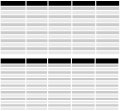
Methods of
Improving Biodiesel Viscosity With Changing Temperature and Time
O.E.
Onyejekwe, J.M. Yazzie
Flagstaff Renewable
Fuels, 8610 Arroyo Trl, Flagstaff AZ 86004, NAU Department of Environmental
Engineering










Introduction-Transeterification

Methods

Capstone Modification

TEST SAMPLES

Company Contacts

Results

Analysis

Acknowledgements
Biodiesel assumed good enough, and
washing shall be done by other FRF Capstone Group
Biodiesel assumed to be of high
quality i.e. free of glycerin
Biodiesel assumed of high quality,
further quality testing of biodiesel will be done by other FRF Capstone
Group
-newspaper test, similar to the
purpose of the Drying Test, same reason for exclusion from our project

Conclusion

Abstract


Edward Smith
(Client)
Brandon Doss
Bridget Bero PhD
NAU Civil &
Environmental Engineering
Joshua Hews PhD,
P.E.
Adverse
Conditions:
Kerosene B-60 performed best followed by Ethanol
B-60
Normal
Conditions:
Ethanol B-60 performed
best, followed by methanol B-60
Diesel:
Performed poorly in all
test
ROHMAX:
(commercial product)
Performed poorly in the
freezing test
Alternative diesel
fuels are an ever-increasing necessity and demand in the world we live in
today. Biodiesels are composed of vegetable oils and their derivatives such as
methyl esters. The problem with most Biodiesel is their inability to perform
under cold temperatures. They clog up a diesel engine and render the system
inoperable. This project seeks to find the most efficient blend of alcohols,
kerosene, polymethacrylates, olefin Copolymers (i.e. ethylene and propylene)
and ploy-a-olefins to sustain their crystalline structures and prevent engine
clogging at low temperatures. Successful outcome of this project will lead to
further research into improving ester blends in Biodiesel engines under
unfavorable conditions.

College of Engineering
and Natural Sciences


Chemical
Composition
Time (Seconds)
Calibration Factor
Viscosity (centistokes)
Methanol
B-90
37.5
0.002294
0.861
Methanol
B-80
26.13
0.002294
0.0599
Methanol
B-60
22.22
0.002294
0.0510
Diesel
B-90
50.59
0.002294
0.1163
Diesel
B-80
41.28
0.002294
0.0947
Diesel
B-60
36.44
0.002294
0.0836
Kerosene
B-90
37.33
0.002294
0.0896
Kerosene
B-80
36.37
0.002294
0.0834
Kerosene
B-60
24.12
0.002294
0.0553
Ethanol
B-90
41.75
0.002294
0.0958
Ethanol
B-80
33.00
0.002294
0.0757
Ethanol
B-60
22.09
0.002294
0.0507
Chemical
Composition
Time (Seconds)
Calibration Factor
Viscosity (centistokes)
Methanol
*********
***************
**************
*************
Methanol
B-80
43.03
0.002294
0.0964
Methanol
B-60
26.13
0.002294
0.5994
Diesel
*********
***************
**************
*************
Diesel
*********
***************
**************
*************
Diesel
B-60
44.28
0.002294
0.1016
Kerosene
B-90
49.22
0.002294
0.1129
Kerosene
B-80
42.91
0.002294
0.0984
Kerosene
B-60
27.03
0.002294
0.0620
Ethanol
*********
***************
**************
*************
Ethanol
B-80
49.90
0.002294
0.1145
Ethanol
B-60
29.06
0.002294
0.0670
ROHMAX
*********
***************
**************
*************
B-100
*********
***************
**************
*************








•Traditional blends
–Polymethacrylate – long chain ester
–Olefin Copolymer – Ethylene/propylene
non-conjugated diene
–Alcohol- Ethoxylated long chains R-O
•Synthetic blends
–Hydrocarbon liquid (Kerosene) (preferably low amounts due to fire risk)
–Poly-a-olefin- PAO-40 where “40” is the kinematic
viscosity
•Environmentally friendly blends
–Vegetable oil – Heat modified (polymerized) soybean
oil
–Vegetable oil – Mixed fatty acids
–Vegetable oil- Oleic acid alternative
–Rohmax oil additives (Evonik)
•Alcohol
–Ethanol
(NAU)
–Methanol
•Synthetic Blends
–Kerosene
(Store)
–Diesel
•Environmentally Friendly Blends
–Rohmax Oil Additive- (Edward Smith Client)
•Perform various tests with the biodiesel at room and other temperatures to
determine which blend works best
•Repeat tests to determine consistency
•Make a final conclusion based on the group of blends tested


